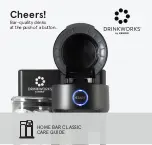
ALARMS!
In case of sensor fault, the regulator gives an alarm and a message
appears on the display: Alarm! Measurement number and name and err.
The alarm relay contact closes (strip connectors 31 and 32).
Measurements 6 and 11
as alarms:
203GT gives an alarm when a situation deviates from the norm. In the event of an alarm, the controller gives an
alarm and an alarm message appears on the display. Also, the alarm relay contact closes. Note! Although the
cause of the alarm has disappeared, the last alarm remains permanently on the display until it is acknowledged. If a
GSM modem has been connected to the controller, the alarm will appear in the desired GSM phone as a text
message. External alarms can also be connected to 203GT, e.g., leakage, network's water pressure, etc. (alarm
labeling is done using the text editor). The controller gives an alarm if the temp of the accumulator's upper part rises
above 95°C. In addition, with geothermal heating at full effect the controller gives an alarm if the controller switches
on the heating resistor.
Digital inputs Dig1, Dig 2 and Dig 3 can be used for receiving external alarms.
The alarms can be labeled according to topics, e.g., "water damage”
(installation p. 34). When the contact connected to the digital input closes, an
alarm goes off and "err” appears on the display. If the alarms are not labeled,
"Alarm!, Dig 1 (2, 3) will appear on the display in the event of an alarm and the
alarm relay contact closes (strip connectors 31 and 32).
Sensor fault alarms:
HW overheating alarm:
Digital inputs as alarms
I
f the HW supply water temperature exceeds the HW alarm limit (factory
setting 70 C), the alarm goes off. The present supply water temperature
appears on the display. The alarm relay contact closes (strip connectors 31
and 32). See "Settings", page 21.
o
Overheating!
04/04
22:40
Measurement 7
HW supply 78
Alarm!
03/04
11:46
Measurement 1
Outdoor temp err
Risk of freezing alarm:
Risk of Freez!
02/02
22:34
Measurement 2
H1 supply
7
The regulator gives a risk of freezing alarm if the supply water temperature
goes below the lower limit set for a free drop in the supply water or the
lower limit set for the room temperature. The present supply water
temperature appears on the display. The alarm relay contact closes (strip
connectors 31 and 32). See special maintenance settings page 30.
EXTERNAL ALARMS:
Measurements 6 and 11 can also be used to indicate external alarms (potential
free switch). In that case a 30k9 resistor must be connected to the strip
connector of the measurement in question.
When the contact is open
"1" appears on the display.
When the switch closes, an
alarm goes off and the alarm
in question appears on the
display.
CONNECTING THE ALARM RELAY:
Alarm
center
31
32
2 x 0.8
24 VAC/ 1A
ALARM ACKNOWLEDGEMENT:
Turn the alarm off by pressing any button. The display will return to the mode it
was in before the fault appeared or if there are additional sensor faults their
alarm information will appear on the display. If you don't press the keyboard in
20 seconds the alarm will return to the display if the fault has not been
corrected.
Deviation alarm:
The regulator gives a deviation alarm if the supply water temp permanently
deviates (factory setting 60 min) from the temp set for it by the regulator.
(The maximum allowed deviation is listed in special maintenance under "H1
Dev. alarm" settings and the duration of the deviation that causes the alarm
to go off is under settings "DevAlaDela", page 30.)
Deviation alarm!
06/05
18:30
Measurement 2
H1 supply 25
30k9
30k9
Closing alarm
Opening alarm
When the contact is closed
"1" appears on the display.
When the switch open, an
alarm goes off and the
alarm in question appears
on the display.
"Risk
of
moisture”
"W
astewater
tank”
"W
ater
pressure”
The GSM modem (optional equipment) offers an economical "miniature monitor
solution”. Alarm information is directed to the desired GSM numbers (1 and 2).
See p. 37). In the event of an alarm, the regulator first sends a text to GSM1
that indicates the cause of the alarm. The alarm is acknowledged when the
same message is sent back to the regulator via the GSM. If the GSM1 does
not acknowledge the alarm in 5 minutes, the regulator will send the text
message again to both GSM numbers.
17
















































